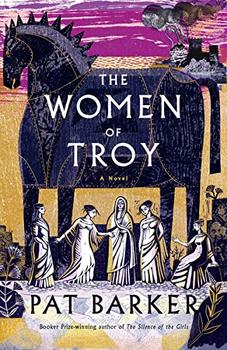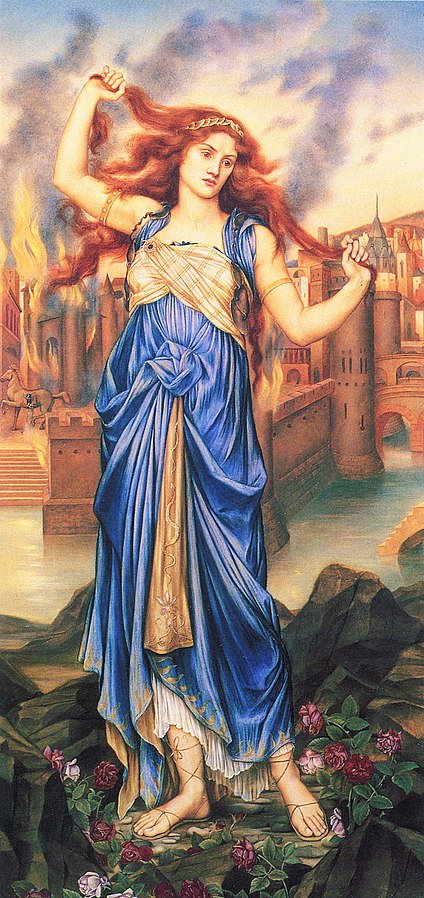Summary | Excerpt | Reading Guide | Reviews | Beyond the Book | Read-Alikes | Genres & Themes | Author Bio

This article relates to The Women of Troy
 Like most stories and characters from Greek mythology, the exact origin of Cassandra of Troy is unknown, though she may have first appeared as a character in the Iliad, composed around the 8th century BCE, where she is described as "the fairest of Priam's daughters" and "fair as golden Venus" (in the English translation by Samuel Butler). These are the only references to Cassandra in Homer's tale, but clearly her story developed elsewhere, as now there is a much larger mythos surrounding her character. Details of Cassandra's story vary in different sources, but the blueprint of her narrative remains generally agreed upon.
Like most stories and characters from Greek mythology, the exact origin of Cassandra of Troy is unknown, though she may have first appeared as a character in the Iliad, composed around the 8th century BCE, where she is described as "the fairest of Priam's daughters" and "fair as golden Venus" (in the English translation by Samuel Butler). These are the only references to Cassandra in Homer's tale, but clearly her story developed elsewhere, as now there is a much larger mythos surrounding her character. Details of Cassandra's story vary in different sources, but the blueprint of her narrative remains generally agreed upon.
Cassandra was the daughter of Priam and Hecuba, the king and queen of Troy during the city's invasion by the Greeks. Though she is often described as very beautiful, Cassandra never married; instead, she was a priestess, who was cursed by Apollo so that her prophecies would never be believed. In some versions of this story, Apollo cursed her for rejecting his sexual advances by spitting in her mouth.
Though Cassandra foresaw the destruction of Troy, she was ignored — in some sources, she was even locked up on orders from her father when her "false" prophecies became a source of irritation. According to The Fall of Troy, which Quintus of Smyrna composed around the 4th century AD, Cassandra even predicted that the Trojan Horse was filled with Greeks. After her prophecy was dismissed, she charged at the Horse with an axe and a torch, but was quickly detained. When the Greeks later emerged from the Trojan Horse, Cassandra took refuge in the temple of Athena, where she was found and raped by Ajax the Lesser.
The end of Cassandra's sad tale is chronicled in The Oresteia, a trilogy of plays written by Aeschylus in the 5th century BCE. The first play, Agamemnon, tells the story of the titular hero traveling home after the Trojan War with Cassandra in tow as a war prize and concubine. When he arrives, Agamemnon is brutally murdered by his wife Clytemnestra and her lover Aegisthus — which Cassandra predicted, though her prophecy was, as always, dismissed as the ravings of a madwoman. She also predicted her own death, which came shortly after, again at the hands of Clytemnestra and Aegisthus. In some versions of the story, Cassandra and Agamemnon had twins, Teledamus and Pelops, also killed by Aegisthus.
Due in part to the proto-feminist thread apparent in Cassandra's narrative (which is, at its core, the story of a woman who is never heard or believed by the men in her life), Cassandra has always been a popular figure and a common focus of Greek mythology retellings. Notable books that expand on Cassandra's story include: Cassandra by Christa Wolf, The Cassandra by Sharma Shields, The Autobiography of Cassandra, Princess & Prophetess of Troy by Ursule Molinaro, A Thousand Ships by Natalie Haynes and Cassandra by Kathryn Gossow.
The Voyage Home, the third novel in Pat Barker's Trojan War series, will be published in 2023, and will be told from the perspective of Cassandra, a character Barker introduces in The Women of Troy.
Cassandra (1898) by Evelyn De Morgan
Filed under Cultural Curiosities
![]() This "beyond the book article" relates to The Women of Troy. It originally ran in October 2021 and has been updated for the
August 2022 paperback edition.
Go to magazine.
This "beyond the book article" relates to The Women of Troy. It originally ran in October 2021 and has been updated for the
August 2022 paperback edition.
Go to magazine.
Your guide toexceptional books
BookBrowse seeks out and recommends the best in contemporary fiction and nonfiction—books that not only engage and entertain but also deepen our understanding of ourselves and the world around us.